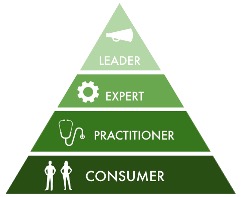Knowledge and Wisdom in R&D

Are you smart and wise enough for the future of R&D?
In the previous contribution is Data the NewOil in R&D too? I discussed the bottom half of the “DIKW” pyramid :
- Data is the raw material at the bottom of the pyramid, possibly without context or use case
- Information is data with context, but possibly still without use case.
- Knowledge is a big word for information ready to be used; in R&D, you may prefer “Know-how” as the K-word.
- Wisdom is an even bigger word for being able to decide “What” to do “Why”, giving us two simple W-words.
The key message of the previous article is that turning data in information requires resources. Let’s go and look for the benefits in the upper half of the DIKW pyramid. The potential of the democratisation of knowledge is huge and its implementation will take wise leaders.
Then the knowledge comes for free?
The definition of knowledge is ambiguous: Knowledge Management (KM), information science, and philosophy take different positions, and even within these domains opinions vary. In the framework of the DIKW pyramid, a piece of knowledge is built on an information set. For of an expert in the scientific discipline, teaming up with skilled data scientist, this information set is already knowledge, because it is all they need for the benefit of their company.
Well performing teams like that are rare and must be deployed strategically, in particular to converting an information set into a scientific model, with proper documentation and validation. The model may be an equation or an algorithm, often encoded in a tool. This makes the piece of knowledge easier to use properly for “practitioners”, who typically know the use case well but have limited experience in the scientific discipline, but enough to apply the equation or run the tool correctly.
A tale from my experience at Unilever
My own experience with KM in the 1990’s at Unilever (2) was all about extraction the internal knowledge from experts, sometimes named “tacit” knowledge because the experts only share it when asked the right questions; otherwise, it just sits in their heads. By the way, most of them were proud to share their knowledge, so no improper extraction methods were applied. Primarily the experts shared their insights, followed by references to (internal) reports containing scientific models and the underpinning information. I never denied the value of facilitating the transformation of the tacit information of experts into explicit information to be internalised by other experts and practitioners. However, with my background in molecular modelling and simulation, I insisted that the extracted knowledge should be used to make software tools for the practitioners and knowledge consumers. That did not happen in most cases and I lost my interest in KM.
About 15 years later I was working as an IT manager on the IT strategy for Unilever R&D and got involved in a tool predicting the growth of micro-organisms on media like Foods products. It was built on knowledge from mainly chemists and microbiologists as extracted by the KM team. It had been developed to be useful for product developers in Foods, many having little or no knowledge of chemistry and microbiology, and thus at best practitioners for the knowledge implemented in the tool. Later, this tool had been extended to predict many other properties of the same Foods products based on knowledge from many other scientific domains, so nobody can claim to be an expert or even practitioner of all domains.
 The target users became “knowledge consumers”, typical product developers. By tuning the user interface of the tool to their tacit knowledge level, their vocabulary, and their way of working, the use of the tool proliferated quickly. This is a milestone in building the DIKW pyramid: a tool that democratises the knowledge of experts in multiple scientific disciplines, represented in hidden scientific models, and easy to use for “knowledge consumers” (3).
The target users became “knowledge consumers”, typical product developers. By tuning the user interface of the tool to their tacit knowledge level, their vocabulary, and their way of working, the use of the tool proliferated quickly. This is a milestone in building the DIKW pyramid: a tool that democratises the knowledge of experts in multiple scientific disciplines, represented in hidden scientific models, and easy to use for “knowledge consumers” (3).
Yet another pyramid
In the previous paragraph, I defined a people knowledge pyramid which have traversed almost top-down: expert, practitioner, and consumer. The top level marked “leader” is about managing the knowledge democratisation and is explained below. The width of the layers represents the number of people to remind us of the multiplication of usage by embedding expert knowledge in tools for practitioners and consumers respectively. It complements the bottom layers of the DIKW pyramid, in which the knowledge is created bottom-up.
R&D cannot fuel a business without destination
My bottom-up traversal of the DIKW pyramid suggests that data evolves via information into knowledge like by organic growth, and often that how it starts. In my 30 years at Unilever, I have seen that it became more difficult for these bottom-up initiatives to mature by the introduction of project management and stricter budgeting, both disfavouring long-term processes like building and maintaining information sets, scientific models, and R&D-specific IT tools. However, I have also experienced that management championed existing bottom-up initiatives and stimulated new ones after seeing increasing benefits delivered at each layer like better data quality, reuse of information, and democratisation of knowledge. These benefits outweigh the cost in time from the scientists and technicians performing the lab work, additional roles like data stewards (4) and tool support, a continuous development team (R&D and IT), and IT tools.
At the top of the DIKW pyramid, “business-wise” people establish what the value and cost of pieces of knowledge are (“why”) and decide to which ones the always scarce resources are allocated (”what”). Senior management gets involved in these decisions once the organisation realises that each piece of knowledge is a company asset. In this perspective, the investment in democratised knowledge is top-down. This does not contradict the above when taking the progressing maturity of knowledge into account, but that is another story.
Imagine the digital knowledge revolution
The implementation of a tool to democratise knowledge throughout an organisation will transform the way innovation is done far more than speeding up the current R&D process. It will affect the roles within R&D, create new kinds of collaboration with other functions, stimulate the growth of the knowledge market, and allow exponential combination with other transformational technologies like Artificial Intelligence (5). Managing this revolution will take a lot of Wisdom – take this capital W as an understatement.
Acknowledgement
The creation of the tool involved many people in Unilever R&D and IT, as well as third parties, but I want to name Sander Dubbelman for his inspirational leadership in the democratisation of knowledge.
Remarks
- The Data-Information-Knowledge-Wisdom pyramid or hierarchy was made a commonly used framework in 1989 by Russell Ackoff, but similar propositions were made before by others.
- I worked 30 years for Unilever as a scientist, IT manager for R&D, and member of the R&D digital transformation team. I use examples from this experience when appropriate.
- I use the more common term data steward as short for DIKW stewards, taking care of the information sets and scientific models also, and monitoring the benefits realised by the democratisation of the knowledge.
- The non-linear effect of combining transformational technologies is described in Ray Kurzweil’s book “The singularity is near” from 2005.
 Rik Pepermans recently established Rik Pepermans Consulting to guide R&D organisations in their digital transformation. He assists his customers in defining their digital ambition, evaluates their current digital maturity, facilitates creating a roadmap to meet their ambition, and supports its implementation.
Rik Pepermans recently established Rik Pepermans Consulting to guide R&D organisations in their digital transformation. He assists his customers in defining their digital ambition, evaluates their current digital maturity, facilitates creating a roadmap to meet their ambition, and supports its implementation.
Rik got a degree in chemical engineering and a PhD in chemistry. He enjoyed the synthesis lab and advanced NMR, but modelling of molecules got him really excited: ”You don’t understand what you cannot simulate.” He started teaching molecular modelling just before he switched to Unilever R&D as my main job but kept teaching for 20 more years to share his vision with a next generation.
After 20 years as a researcher and R&D manager, Rik made a career switch to IT manager for R&D, driven by the vision of a digitised research function. His perseverance as a matchmaker between R&D and IT earned him the nickname “R&D IT Evangelist”. In the last decade, his combined experience in R&D and IT gave him the opportunity to co-shape the digital transformation of Unilever R&D. Now he founded his own company to catalyse the digital transformation of other R&D organisations.
Latest Posts
Press Release PLA® Conferences and 20/15 Visioneers forge strategic collaboration
Paperless Lab Academy® and 20/15 Visioneers forge strategic collaboration to shape the future of scientific and laboratory digital transformation. [M
07 February 2025
Meeting the Challenges of People, Process and Interfacing When Digitalising Labs
As the scientific and industrial landscape continues to evolve, digitalisation has become a cornerstone for innovation and efficiency in laboratory pr
20 January 2025
FAIR Principles and Data Stewardship Discussions at PLA2025Europe
FAIR Principles and Data Stewardship sustain any data centric approach Laboratories are striving for more and more automated and digitalised processes
12 December 2024
